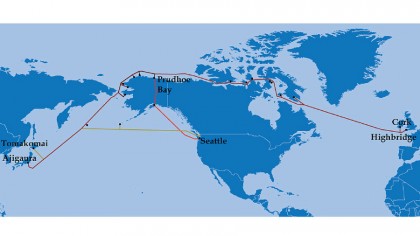The incredible story of the underwater internet
A vast ocean network of fibre optic cables
Do satellites offer a way to get The Next Billion online?
With SpaceX's plan to launch micro-sats and the ambitious Outernet concept, you could be forgiven for thinking that satellites could take over from cables, especially in developing areas of the world. "Satellites are an exciting prospect, but simply not cost-effective for developing nations at this time, and that's where the next billion internet users will come from," says Ranjbar. There's also a latency problem; there will always be about a half-second delay, which renders things like video calling almost unusable.
"Satellites are expensive to launch, they have relatively small traffic capacities, long round-trip-times due to sheer distance to space and back, and they're subject to atmospheric conditions," adds Fisher.
Where submarine cables can't possibly be commercially viable – such as when it comes to lightly populated islands – projects like Google's Loon could be the answer, but only as a last resort.

What about land-locked countries?
Submarine cables obviously don't work for everyone. "Many countries are landlocked and so connectivity to the submarine cables has to be through other countries over fibre networks, which just haven't been built yet," says Eran Yoran, marketing director of Gilat Satcom, which provides satellite and fibre-based connectivity services in Africa, Asia and the Middle East, and is a founding shareholder in WIOCC, which owns 40,000km of submarine cables.
For remote communities, satellite is often the only solution. "Providing affordable access in Africa is an ongoing theme for the telecoms industry," says Yoran, whose company's Village Island scheme provides the internet, VoIP and Video over IP via a private satellite network. Organised through local groups willing to be a nano-ISP – such as a church, a school or a village chief – prices for individual villagers start at a dollar per month. "Village Island is economically self-sustaining and scalable so it can grow with demand and with a minimal additional investment," says Yoran.
Do submarine cables need upgrading to allow The Next Billion online?
Absolutely, and the industry is in a transition from IPv4 to IPv6. "The internet simply cannot support another billion individual connections using the current systems," says Ranjbar. "It's incredibly important for the future growth of the internet that we all focus on deploying IPv6, which has enough address space that we won't have to worry about connectivity for at least several lifetimes."
Happily, that is now happening. "It's one of the first cables to be a pure internet cable," says Vuillemin about Sea-Me-We 5, a 100Gbps link that will have a total capacity of 24 Tbps – the same specs as Arctic Fibre. It also has advanced Wavelength Division Mulitplexing, so optical signals with different wavelengths can be combined and transmitted together – capacity can be increased without anyone ever needing to touch the cables themselves.
Sign up to the TechRadar Pro newsletter to get all the top news, opinion, features and guidance your business needs to succeed!
"Back in 1988 we were talking about megabits and now we are talking about terabits," says Vuillemin. "This is why undersea cables are the only technology that can supply enough bandwidth for the modern internet." Being such an expensive outlay, a submarine cable's exact technological specifications can be everything. "Newer technologies and designs allow for a decreasing cost per bit, which compensates partially for the decrease in generated revenues from data services," says Loos. "The effect of a more efficient newer system can put a significant pressure on the price."
For users of wireless devices, it's easy to assume that the whole chain that carries data is wireless, but the reality behind our modern, digital society is a fantastic engineering feat that should be overlooked no longer. "To stretch a huge cable the length of the Atlantic Ocean just seems so implausible," says Fisher, "but we did it – and it works!"
Jamie is a freelance tech, travel and space journalist based in the UK. He’s been writing regularly for Techradar since it was launched in 2008 and also writes regularly for Forbes, The Telegraph, the South China Morning Post, Sky & Telescope and the Sky At Night magazine as well as other Future titles T3, Digital Camera World, All About Space and Space.com. He also edits two of his own websites, TravGear.com and WhenIsTheNextEclipse.com that reflect his obsession with travel gear and solar eclipse travel. He is the author of A Stargazing Program For Beginners (Springer, 2015),
